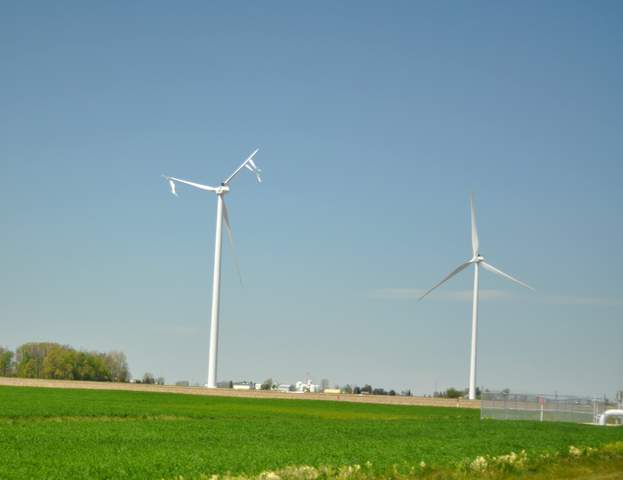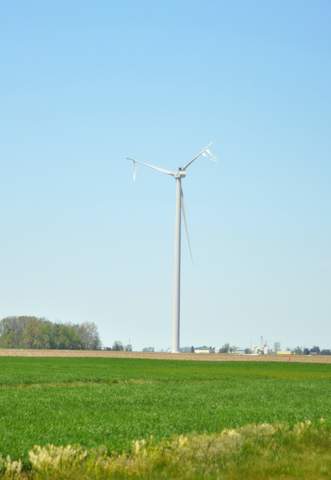4/25/12 Another one bites the dust AND Different state, same nightmare: wind developers pushing for 1000 foot setbacks from 500 foot turbines
MASSIVE WIND DAMAGE CAUSED BY WINDY CONDITIONS
Source WANE, www.wane.com
April 24 2012
A wind turbine in Paulding County, Ohio has been badly damaged.
According to a spokesman with EDP Renewables, the turbine, which is located near Payne, had two of its blades sheared early Tuesday afternoon.
Representatives from EDP Renewables have closed the site, which is known as Timber Road II and said no one was injured by the falling debris.
That particular turbine was completed in 2010 and is still under warranty by its manufacturer Vestas which is conducting their own investigation.
EDP is monitoring other turbines in the area for any signs of fatigue or damage.
NewsChannel 15 received several pictures a damaged turbine in Paulding County. We’ve added them to this story.
New York State
PUBLIC HEARING DRAWS FULL HOUSE
By Chris Hoffman,
Source: Madison County Courier, www.madisoncountycourier.com
April 25, 2012
The crowd at the Public Hearing before the Town of Madison Planning Board nearly filled the 350-seat auditorium at Madison Central School on April 18. The hearing opened at 7 p.m. and more than 40 local residents read comments until almost 10:30 p.m.
Comments were overwhelmingly opposed to the project, with only 7 in favor, most of whom were members of the Stone Family who live near the existing windmills on Stone Road and who stated they have experienced no adverse affects. Several speakers subsequently pointed out, however, that comparing the two projects is meaningless because of the difference in size, scope, and siting.
The proposed wind farm would site 36 turbines within and around a residential area that contains over 150 homes, with each turbine nearly 500 feet tall and within setbacks of 1,000 feet from existing homes. Additionally, the proposed turbines are a new model with no track record, as they have never been used anywhere in the country.
Speakers represented a broad demographic spectrum – people who have lived here since they were young children; people who relocated here to get away from industrialization and overcrowding; fourth generation farmers and new farmers; business owners with past experience in the energy and construction industries; homeowners who have lived here for decades and built or bought their homes because of the proximity to a serene natural environment.
Many speakers addressed specific sections of the draft Generic Environmental Statement (dGEIS) submitted to the Planning Board for review, pointing out numerous flaws and inadequacies. Jane Welsh stated that the Planning Board should never have accepted the dGEIS for review because it is incomplete as it stands, and should have been returned to the developer for corrections.
Laura Wilson of Hamilton Village Real Estate and Sue Martin of Martin Realty both spoke to the “blatant inadequacy” of the section in the dGEIS concerning real property values, which sites a 2009 report that states, “neither the view of the wind facilities nor the distance of the home to those facilities is found to have any consistent, measurable, and statistically significant effect on home sales prices.” Both Wilson and Martin, who have more than 50 years of combined experience in the local real estate market, cited studies and data that refuted this conclusion, and termed the report relied on by the dGEIS as fatally flawed and outdated.
Bob Albrecht spoke of childhood memories of growing up on Thayer Road, where he and his brother Carl used to play in the woods among the trees, trees that he has always referred to as the “Witness Trees,” because they have been there so long that they bear witness to the generations of families who live in this area, noting that “individuals have a reasonable expectation to the quiet enjoyment of their homes.”
Eve Ann Shwartz spoke on behalf of the Hamilton Town Council.
“The Hamilton Town Council believes that the proposed project would violate Town of Hamilton laws adopted to protect our citizens from the negative impact of improperly planned windpower projects,” Shwartz said. “With the currently proposed siting, Hamilton properties bordering on the Madison town line may be subject to quality of life impingements and health concerns such as flicker effect and noise pollution. The Town of Madison’s current regulations and buffers are not as protective as those provided under the Town of Hamilton’s zoning.”
“While we understand that the Town of Madison’s laws control the development of land in Madison, we believe that the siting of wind farms is a unique type of land use,” she added. “Because wind turbines can be seen for many miles and the noise they generate and the shadows they create can extend for thousands of feet, their impacts can extend beyond town boundaries. We respectfully request that you honor the intent of our laws and modify the siting of the proposed project.”
Shwartz also addressed the potential impact on property values.
“The proposed project is sited within one mile of 92 properties in the Town of Hamilton, covering 1,807 acres with an assessed value of $8,716,400,” Shwartz said. “According to numerous studies, wind turbine projects have a negative impact on nearby property values. A recent study of more than 11,000 property transactions in Franklin, Clinton, and Lewis Counties found an average reduction in value of 7-15 percent for properties located within one mile of wind turbine projects. Owners of these 92 properties will experience a collective loss of value ranging from $610,148 to $1,307,460. The Town of Hamilton will likewise see its tax base eroded by the same amounts, resulting in lower property tax and sales tax revenues.”
Shwartz requested that the Town of Madison demand larger setbacks from properties located within the Town of Hamilton.
Additionally, Shwartz requested that any PILOT payments going to the Town of Madison be shared proportionally with the Town of Hamilton, “to reflect that portion of our town residents with impacted viewscapes, and that the PILOTS be increased to $7,500/MW in order to compensate Town of Hamilton taxpayers for the loss of property values.”
Town of Madison Supervisor Ron Bono stepped up to the microphone about midway through the evening. The room went silent, waiting to hear what Bono would say. He said, “After taking the trip to Hardscrabble Wind Farm in Fairfield last Sunday, and seeing windmills in every direction, I now want to see the size and number of these proposed windmills reduced, as I do not want to change the landscape of Madison.” The crowd erupted in applause.
The Town of Madison Planning Board will continue to accept written comments on the dGEIS until 5 pm on Friday, May 18. Written comments will be given the same consideration as oral comments made at the public hearing, and may be submitted by mail (certified mail is recommended) to the Town of Madison Planning Board, P. O. Box 66, Madison, NY 13402. After the comment period ends on May 18, the Planning Board has 30 days to review all comments.
The dGEIS is available online at http://madisonmatters.org/dgeis/, where it has been divided into individual chapters and appendices for easier viewing.
Chris Hoffman is a freelance reporter for the Madison County Courier.




